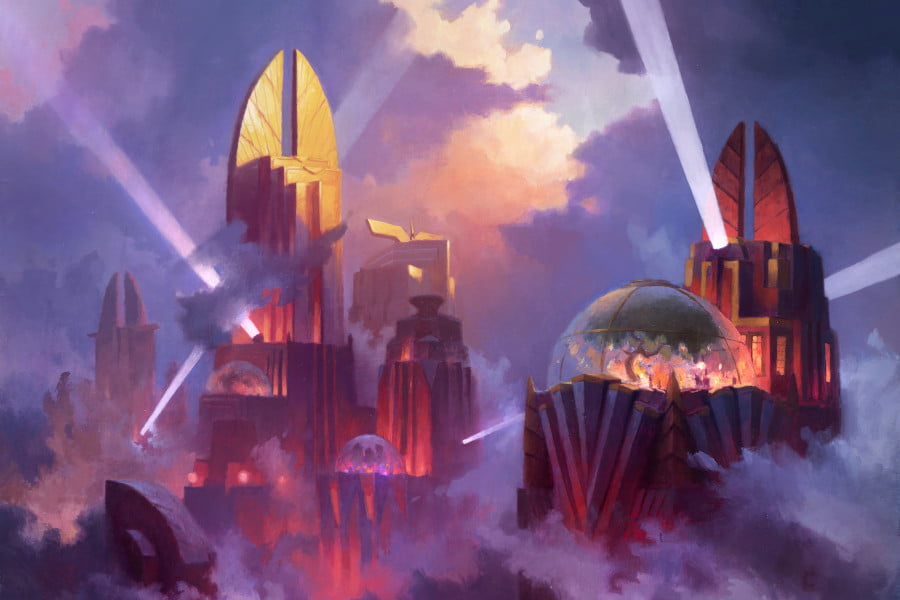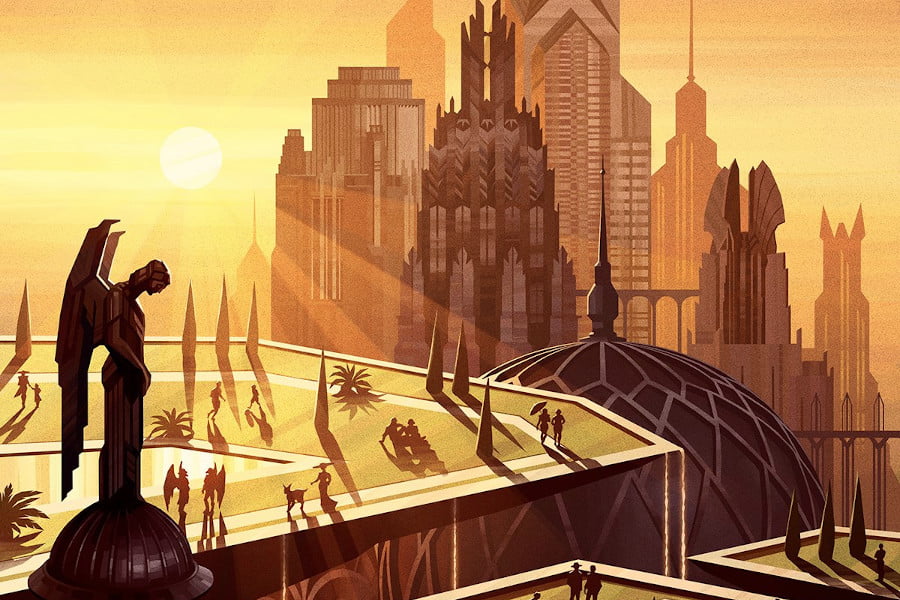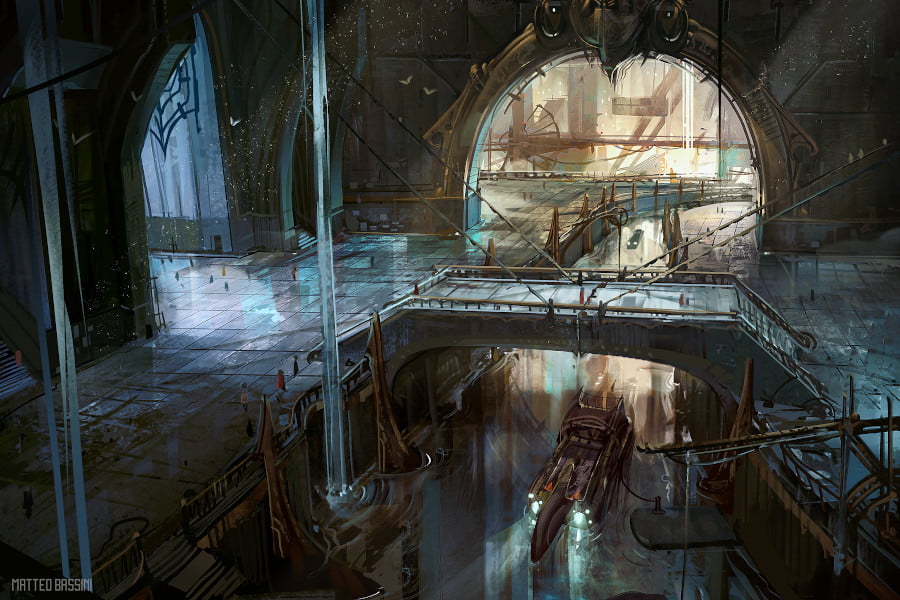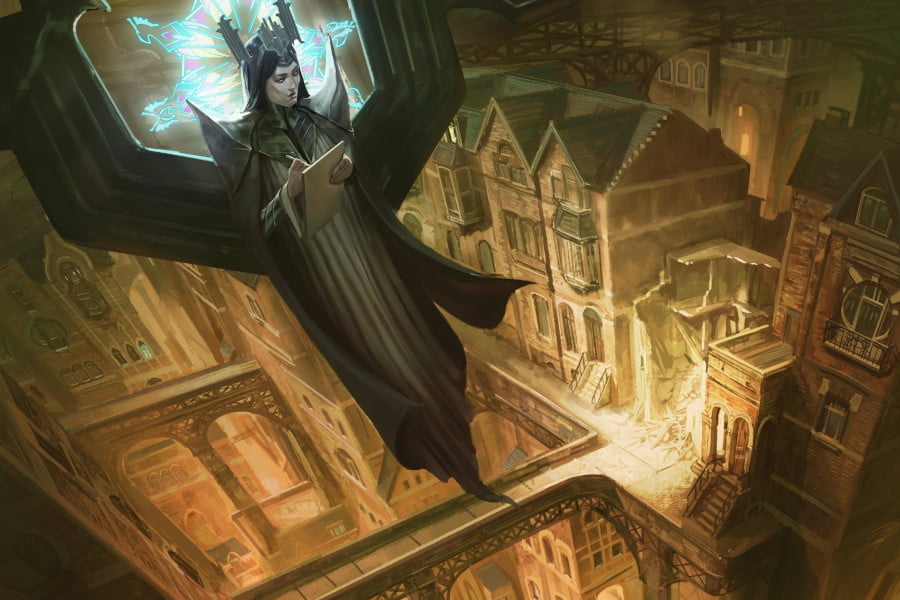Cobrin’Seil is a place with culture, a place with languages, a place where people make books and exchange culture and share popular media just like in the real world. Places have their styles and preferences and they absolutely have their own trash. Trash novels, for example, cheaply made on pulpable paper, are traded around in bulk between different cities, and a surprising number of them, the really cheap ones about sleazy sex and dangerous romance? Chances are they deal in the stereotype of the glitzy and hedonistic lifestyles people imagine is common in one of the glimmering cities of Visente (pronounced vy-zent).

This is going to be a nation write-up! If you want to read the structure, and how it’s to be used, here’s the link to the structure. I did use some resources to help me build this and get over the things I find the most difficult. Particularly, I punched ‘random city name generator’ into duckduckgo and got this link, and the art that informed the concept is from the Streets of New Capenna set from Magic: The Gathering.
Visente
Semi-coastal Urbanised Independent Nation, the Land of Three Cities
Cultures
Most people in Visente live in the Three Cities (Araduin, Duinsiva, and Viduinta) which encourage a lot of travel to central locations along the canals. There’s plenty of work in the cities for a variety of different skillsets, and services for people with specialised needs. These cities, being large urban centres, have a huge variety of people, meaning that almost anyone of any heritage shows up in the cities. Outside of the three cities of Visente, things become more pastoral and communities are more likely to be composed of similar groupings of people, and out in the woods and other dangerous spaces, there are smaller communities of isolationists.
Common: Abilen, Goblins, Half-Elves, Half-Orcs, Halflings, Humans
Uncommon: Eladrin, Elves, Kobolds, Orcs,Tieflings
Rare: Dio Baragh, Drow, Shadar-Kai

Reputation
The cities of Visente are its most well-known features, so much so that most people with any awareness of the country probably knows them by name. The way those cities are distinct in their archaeological styles and the way that they’re important to the country at large plays into this national reputation.
Visente is known for its cities so much so that people often think of the countryside villages and towns on the network of canals as being full of people living near Visente, rather than being part of the territory that makes up Visente itself. These towns are often extremely provincial in their cultural identity, and think of themselves in terms of their primary contributions to the nearest city, or cities, including the towns who are just distribution centres, warehouses and dockhouses, or the towns that are primarily residential housing for people who work in those cities.
Common Rumours
Most people have heard one of these basic ideas expressed about Visente:
- “Visente are allergic to horses.”
- “Visente are romantic idealists.”
- “Visente druids are powerful.”
- “Visente people are ambidextrous.”
Locals
The most common cultural experience of the locals of Visente is living in a society where everything is indirect. In the city, everyone has jobs or roles that require them to deliver things from one place to another, often things that you don’t necessarily even see or deal with. Dock workers move goods in crates they don’t see to be warehoused by merchants they don’t know for the purchase by businesses they don’t frequent. Even the rural farm life of Visente tends towards this, where people who grow their own food still send the majority of it ‘up’ the canals, towards the cities, and tend to rely on things sent from the same. Even the exchanges between adventurers and druids tend to be two other people’s business.
This tends to produce a profound feeling of cooperative interconnectedness in some and a feeling of profound alienation in others. The national character tends towards being extremely romantic, in the sense that Visente people are prone to assuming that feelings are the most important things, and that feeling very hard is enough of a reason to get to do something — a society of dreamers and ambitious hopefuls, all convinced they can make it big in the cities. This can often run headlong into problems of a lack of resources to make those dreams come true, meaning that everyone knows someone whose story ends in a complete downer, but maybe it won’t for me.
This is also why almost everyone who lives in one of the cities knows someone who is probably a criminal, or failing that definitely a criminal.
Visente City Character Concepts
Here are some common ideas for the kinds of characters that you might be able to make from Visente’s cities:
- A dashing, dual-wielding swashbuckler
- A chancy swindler with a dream
- A criminal syndicate heavy hitter
- A scholarly mage from one of the city’s universities
- A detail-oriented clerk or fixer for a business
Outside of the cities, there is the rural and forested area of Visent. These forests are primarily evergreen, hardy and handle the snow and rain very well. Across the land there are small villages and townships, usually dedicated to a particular form of industry that they then deliver to the cities. This can mean a town where a shocking number of people bake bread, make shoes, grow a particular type of fruit, nut, or herb, and these villages are often extremely pastoral if not a little quaint in their reliance on the city industries.
Another element of the rural life is the importance of druidic culture. Growth of crops, maintenance of the canals and the calming of the weather is all done by druidic ritual, which also means that almost every town has some dedicated behaviour or local belief which is for the benefit of a local druid, who typically negotiate some long-term plan that they hope will make the area better for nature and to maintain balance with the city over time.
Visente Rural Character Concepts
Here are some common ideas for the kinds of characters that you might be able to make from Visente’s wilderness areas:
- A village’s guardian ranger
- A druid pursuing some obscure ends
- A scholar seeking to understand ancient druidic traditions

Faith is important to the people of Visente but it’s much like a local sport team, where the more local an area is, the more specific their interest, and the more likely you are to be very invested in that specificity. Broadly speaking, there are three categories of faiths of Visente, presenting the City Gods, the Druidic Circle Gods, and the internationally represented Great Faiths.
Great Faiths are the churches represented worldwide that have some relationship to the society of Visente. The gods most represented in this category in a public, clearly known way are Palescai, Mror, Gwynnym and the Briarhorn, who each have representation enough in the society that people recognise their names and businesses or community groups that relate to them. Evil gods are most known by how people swear about them, which is how most people of Visente know the Fortuneseeker: Some common swears include ‘fortune’s teeth’ and ‘red hand take you,’ referencing that god.
The Druidic Circle Gods range from other internationally known gods like Acydea and the Briarhorn as typical divine fonts of nature worship, but the complicated druidic traditions of Visente mean that there is a veritable daily calendar of increasingly specific gods of different scopes that the this tradition ostensibly worships all equally; in any given day, there’s a single small deity’s festival, but also gods of larger scope are honored in that week, of a larger scope still that month, then with four nation-wide gods of seasons, and the years being marked as belonging to specific internationally-known nature Gods. This level of detail is in part assisted by the work of the Great Henge, which has enough room and detail on it to account for a sprawling ecosystem of gods, and the Druidic tradition’s vision of an interconnected nature means that if you worship this tradition, you probably know, or can intuit from week to week, where in that complex calendar you lie and who is being honoured by that week’s deeds.
Finally, there are the three gods of the cities, Aphaethen, Ciltroen, and Ettris. Myths about these gods present three generally recognised common origins for them:
- They are the divinely exalted spirits of the city’s founders, hence their names
- They are sibling deities who each adopted a city when Visente proved itself worthy
- They are three aspects of one god that blessed the union of the cities and doesn’t know it’s known by three identities
Whatever your flavour of those beliefs you have, the actual presentation of them is highly flexible within the city: usually, cities represent them as individuals, with each one having something about their depiction that shows two identical things to represent the other two cities. This also plays into a coincidental historical note that a large number of Visente’s more known heroes tend towards wielding two weapons or sword-and-shield styles, making it something of an iconic image of the Visente cultural character.
Travellers
The three cities are extremely open to travellers. They have services available for travellers, short-term lodgings for money, and even workplaces where you can stay that pay for your rest. Work is freely available, if at rates that exploit people’s lack of established roots. If you’re travelling on from the cities, you’ll usually be able to get jobs transporting, selling, or guarding canal boats, letting you move up the system. There’s also a lot of demand for entertainers in the cities, on the higher echelons of the cities — there’s almost always a masquerade or a ball happening every week, and there’s always work for people who know how to take orders. Of course, these can often introduce travellers to the kinds of security measures that these cities use to maintain their idyllic lifestyle.
A thing most travellers will notice is that Visente is a nation completely untouched by the typical norm of proximity to the Eresh Protectorate and its highway. It’s one of the only states which does not recognise legal authority of church knights, and does not have any element of the King’s Highway present in the borders. Travel across the country and throughout the cities is overwhelmingly done by canal boat, and the cities are designed to be largely about foot traffic. This is also the root of the rumour that Visente people are allergic to horses: The cities do not permit horses or wagons in travel routes, though there are horses pulling canal boats, powering walking pulleys, and doing other transport jobs down in the lower levels of the city.
Rivalries
Dal Raeda and the Eresh Protectorates do not have a particular position on Visente and its cities; some military types may believe the city lacks for a seriously powerful military force and therefore, it’s a non-factor in military engagements. By comparison, it’s pretty common for the Visente to take a ‘wait and see’ position there – there’s even been some claims about the idea that we can do war wholesale, but none of these ideas have been contested. The unknown factor in all of this is how the druidic circles of the country consider themselves and whether they care about defending the cities or not.

Trade
Trade is the blood that flows along those canals. Almost every major settlement in Visente is built around some form of trade, and even the criminal syndicates that operate in the city stylise themselves as business-oriented, not turf-oriented.
Note that there are some things that Visente doesn’t export, but do sell to exporters. This is a distinction without much difference – people bring transport to the city, buy huge quantities of a product at a marked up rate, then travel away with it and sell it on at other locations. This is usually tied to the rules of some druidic pact: A lot of the food that Visente produces is to be used for the people’s advantage, and this practice is maintained so that the businesspeople can claim to the druids that they’re keeping true to the deal.
This also plays into your normal everyday life: Poor and working class people in Visente have definitely had fresh fruit and vegetables, but only the things that are grown within the country, and almost no goods that are – for one reason or another – not permitted for production in the country. This means that chefs and food prep in the cities tend to consider things in terms of their methods, more than their ingredients.
Makes and Sells: Visente grows huge amounts of fruit and vegetables, but also lots of books, musical compositions, and also manufacture some of the best glass in the world. They also export fine weaponry and magical scholarship.
Wants and Buys: Almost all fine goods that other cultures can make in bulk; refined materials like oil, and steel. Small-level consumable foodstuffs like cases of wine for an individual party rather than commercial import scale quantities. Also, to many people’s surprise, they tend to buy boats from the shipyards of Amenti, rather than build their own.
Important Sites
Araduin
At the end of the Sendu river, Araduin is positioned between the clefts of two coastal cliffs, where the clouds famously tumble down the mountains and leave only the tops of the city’s skyscraper towers jut free from the mists. It’s coastal, and renowned for its high arch vaulted lifts that support the city over a vast dock that lets the canal boats and oceangoing vessels do trade with one another.
Duinsiva
High up in the mountains at the headwaters of the Sendu river, Duinsiva is a cold city, renowned for its snowy landscapes and the beautiful architecture used to direct wind away from the wealthiest places. This has the effect of making the poorer districts colder and windier, while vast glass windows look out on swirling snowflakes in well-heated apartments.
Viduinta
Midway along the Sendu river, the city of Viduinta is renowned for its adventurers guild, who are famous for their recruiters and an organisation program that finds adventurers outside of the city to try and do the many tasks needed to best please the druids of Visente.
The Endless Henge
Druids do not necessarily view money as an inherent good. This means that there’s a real challenge in finding ways that the businesses of Visente can ‘pay’ for the services of the druids. One of the things that has happened, over the course of many years, is that the Visente business leaders have been spending money renovating and expanding and developing and contributing to the development of a henge in the middle of the woods. The endless henge is now over a kilometer across, with elaborately crafted reliefs and carefully cultivated plants and the finest development that money can buy. The result is that the henge is a very important site, visited by adventurers protecting travellers and tourists, and occasionally, the druids it was made for even show up.
The Endless Henge is still being built.